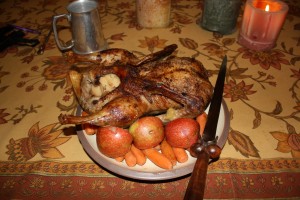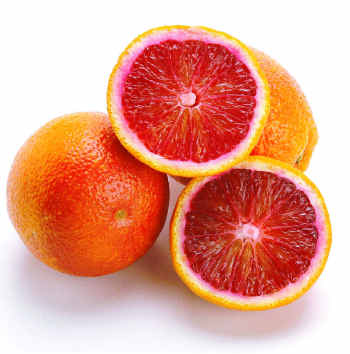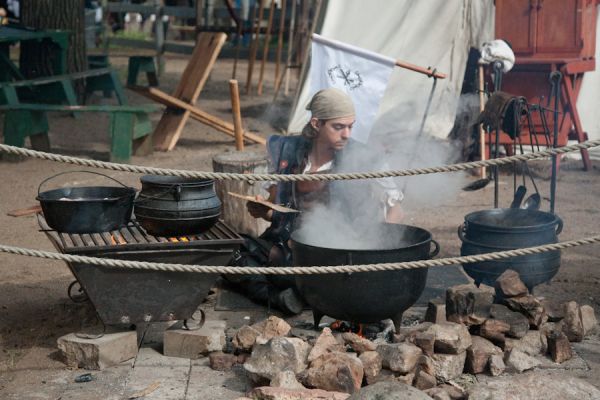Unless readily available, spices we’ve grown accustomed to today were very expensive and hard to obtain during the Renaissance. Salt was rarely used and the spices from the Silk Road – cinnamon, clove, allspice, mace, and ginger, gradually migrated from the Silk Road, across the Arab nations, up the Mediterranean, and north throughout Europe. France, one of the first cultures to embrace these new spices, would blend them with other, more familiar ingredients, and present the dishes to the royal family and visiting nobles.
Although this recipe was prepared originally for nobles, it can be recreated in one’s own kitchen. This dish is ideal for an evening of wine, candlelight, and romance. The brandy and apple sweetened duck meat, complements the baked apples and the carrots and can become even more decadent with toasted bread, truffle oil, and a dessert small enough to share.
1 whole duck (4-5 lbs.)
3 tart apples (more apples may be used as well)
3 cups brandy
1.5 cups of apple cider
¼ tsp ground cinnamon
¼ tsp of fresh orange zest
1/8 tsp ground clove
1/8 tsp ground allspice
1/8 tsp ground cardamom seed
pinch of mace
3 tbsp butter
2 cups of young carrots (baby carrots may be used instead)
salt and pepper to taste
Begin the recipe by rinsing the inside of the duck with cold water and pat dry with a clean towel. Blend the brandy and apple cider together in a bowl. Take one apples and remove the core, and slice it into quarters. Place those quarters into the cavity of the duck. Invert the duck, so that the opening of the body cavity is on top, and place into a separate, deep bowl or freezer bag. Pour the brandy/cider mixture into the body cavity. The liquid should overfill the duck and the remaining liquid should remain in the bowl, and set aside to chill for one hour.
Pre-heat over to 400 degrees.
Take a pot large enough to all the duck to lay flat. Melt butter in the pot; add the carrots, and sauté lightly. While sautéing, mix the clove, cinnamon, allspice, cardamom seed, orange zest, and mace together. Once the carrots are covered in the butter, lay t

hem flat in the pot. Drain the brandy/cider mixture from the duck and reserve. Place the duck on top of the carrots and score the skin of the duck so that the fat may run into the pot. Pour the reserved brandy/cider mixture over the duck.
Sprinkle the spice mixture on top of the duck and cover. Bake for 1 hour. Remove half to two-thirds of the juices
from the pot to let simmer to a reduction in a separate pot. Core the other two or more apples and add to the pot. Uncover the duck and bake for an additional half an hour until juices of the duck run pink. Remove the duck, baked apples, and carrots from the pan and let it sit for 10 minutes before carving the duck. Sprinkle some salt and pepper to taste and serve with the sauce reduction as a garnish. Serves 4
The recipe requires some time to set up, but it is easy to prepare. While cooking, one can set the table and get ready for an evening of flirtatious conversation and romance.





